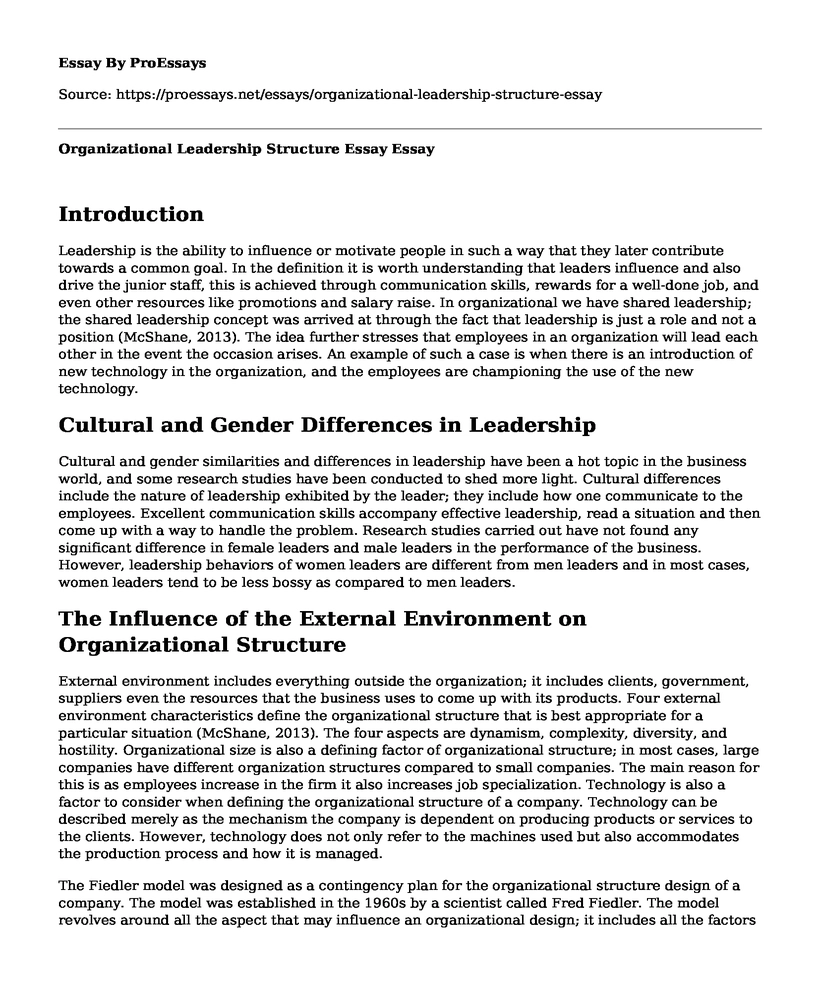Introduction
Leadership is the ability to influence or motivate people in such a way that they later contribute towards a common goal. In the definition it is worth understanding that leaders influence and also drive the junior staff, this is achieved through communication skills, rewards for a well-done job, and even other resources like promotions and salary raise. In organizational we have shared leadership; the shared leadership concept was arrived at through the fact that leadership is just a role and not a position (McShane, 2013). The idea further stresses that employees in an organization will lead each other in the event the occasion arises. An example of such a case is when there is an introduction of new technology in the organization, and the employees are championing the use of the new technology.
Cultural and Gender Differences in Leadership
Cultural and gender similarities and differences in leadership have been a hot topic in the business world, and some research studies have been conducted to shed more light. Cultural differences include the nature of leadership exhibited by the leader; they include how one communicate to the employees. Excellent communication skills accompany effective leadership, read a situation and then come up with a way to handle the problem. Research studies carried out have not found any significant difference in female leaders and male leaders in the performance of the business. However, leadership behaviors of women leaders are different from men leaders and in most cases, women leaders tend to be less bossy as compared to men leaders.
The Influence of the External Environment on Organizational Structure
External environment includes everything outside the organization; it includes clients, government, suppliers even the resources that the business uses to come up with its products. Four external environment characteristics define the organizational structure that is best appropriate for a particular situation (McShane, 2013). The four aspects are dynamism, complexity, diversity, and hostility. Organizational size is also a defining factor of organizational structure; in most cases, large companies have different organization structures compared to small companies. The main reason for this is as employees increase in the firm it also increases job specialization. Technology is also a factor to consider when defining the organizational structure of a company. Technology can be described merely as the mechanism the company is dependent on producing products or services to the clients. However, technology does not only refer to the machines used but also accommodates the production process and how it is managed.
The Fiedler model was designed as a contingency plan for the organizational structure design of a company. The model was established in the 1960s by a scientist called Fred Fiedler. The model revolves around all the aspect that may influence an organizational design; it includes all the factors from the size of the firm, technology, external environment and also strategy design of the firm. The model has a scale that rates least preferred co-worker. In most cases, the conceptual design of the Fiedler's model is used as a benchmark for organizational structure design. The model also acknowledges that good leadership is not only dependent on the style of leading but also takes into account how a leader controls a particular situation.
Conclusion
In practice, there are two types of leaders namely task-oriented leaders and people-oriented leaders. The two differ in the leadership styles, task-oriented leaders use tasks to delegate, in this case, employees are assigned specific tasks depending on their skills and knowledge (McShane, 2013). On the other hand, people-oriented leaders tend to be more interested in the employees. In most cases, people-oriented leaders listen more, show more appreciation and are considerate to the employees. In schools' teachers use both task-oriented and people-oriented leadership skills, the teacher needs to understand the strength of every student hence will provide assignments and also takes time to get to know the student.
References
McShane, S. L. (2013). Organizational behavior: Emerging knowledge, global reality (6th ed.). New York: McGraw-Hill/Irwin.
Cite this page
Organizational Leadership Structure Essay. (2022, Jun 20). Retrieved from https://proessays.net/essays/organizational-leadership-structure-essay
If you are the original author of this essay and no longer wish to have it published on the ProEssays website, please click below to request its removal:
- Paper Example on Diversity, High Performing Teams, and Creativity or Innovation
- Religious Studies: Anytown Community Church Case Study
- Essay Sample on Benefits Company Gained From Change in Organizational Structure
- Essay Sample on Canadian Retirees
- Essay Sample on Reforming Business Organizations: The Zendesk Model vs. Henri Fayol's Five Pillars
- Essay Example on Organizational Culture: Distinguishing One Org from Another
- Generic and Corporate Strategies of the Bank of America







